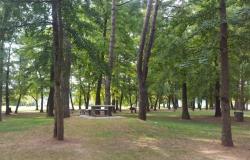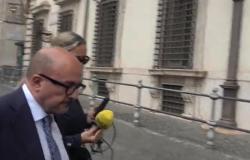In Lecce, a stone’s throw from the magnificent Triumphal Arch built in honor of Charles V, the Paisiello Municipal Theater lives in all its splendor[1], a real “favor” of absolute elegance. Various information on the history of the Theater in the city was offered in the eighteenth century by Francesco Antonio Piccinni, of the Civil class of the city of Lecce, in his “Notizie” relating to the period from 1723 to 1779[2]. Those chronicles, of great interest, were then recalled by Luigi Giuseppe De Simone in “Lecce and its monuments”, a work from 1874, republished just under a century later, with an annotated edition by Nicola Vacca, recently reprinted by M. Cazzato[3].
The people of Lecce have always been lovers of theatrical performances which, until the mid-18th century, took place in homes, in church oratories or in second-hand wooden theatres. The Theatre, at the time called “New Theatre”, was built in a very short time and inaugurated on 4 November 1759 with the comic opera “La Gelosia” by maestro Niccolò Piccinni da Bari, a famous composer in Italy and France. A century later, in 1858 that place was in great vogue.
Pietro Palumbo, in “Pagine del Risorgimento Salentino”, wrote there that the best musical works of the time were performed and that in that period “there were three companies. Volpari and Morghen represented La Traviata, Borghi sang in Rigoletto, Il Trovatore and Lucrezia Borgia, which was then called Elisa Fosco. The Blasi couple entertained themselves with Don Checco, Betly and Eleonora. The seats in the stalls were skeleton-style and anyone who wanted a cushion had to pay two cents for it. The police occupied a box on the right side of the stage and ensured that students did not enter and distract themselves from their studies.” [4].
A few years later, in 1867, the Teatro Nuovo was handed over to the Municipality which took care of its reconstruction. Reopened to the public in 1870, the Theater is named in memory of the great Taranto musician Giovanni Paisiello[5]. Born in Taranto in 1740, Paisiello, rather than codes and pandects, as his father would have wanted, very early on had books and texts on harmony in his hands. After studying in Naples at the Conservatory of Sant’Onofrio, he demonstrated remarkable musical talent, making himself noticed for his comic operas. His fame led him to long stays abroad.
First in Petersburg, where he remained until February 1784 in the service of Tsarina Catherine II. Here he composed various works, including the Barber of Seville, later considered by Gioacchino Rossini to be a “true jewel of spontaneous melodies and scenic spirit”[6]. Then, passing through Vienna, invited by Emperor Joseph, a fervent admirer of him, he played music for King Theodore in Venice, taken from the libretto by Giovanni Battista Casti. Returning to Naples, Paisiello was appointed chapel master and court composer by King Ferdinand.
The success of the “Nina crazy for love”, an opera performed in December 1789 at the Teatro San Carlo in Naples. His sympathies for the revolutionaries of 1799 caused him to fall into disgrace upon the return of the Bourbons, with the end of the Neapolitan republic. Having regained his pardon from the sovereign, he went to France, accepting Napoleon’s invitation in 1802.
Poorly settling into the difficult musical environment of Paris, Paisiello returned to Naples towards the end of August 1804, after having composed a Missa solemnis it’s a Te Deum intended for Napoleon’s coronation in Notre Dame (2 December 1804). In the Naples of Giuseppe Bonaparte and Gioacchino Murat he was awarded various honors (Academic of Italy, May 1807; Knight of the Royal Order of the Two Sicilies, May 1808) and passed away in 1816.
The Lecce Theater, named in his memory, among the most elegant in the Kingdom, has been able to preserve the noble artistic traditions. In the foyer, of refined elegance, in special niches the busts of Giovanni Paisiello and Leonardo Leo are kept, the work of the illustrious sculptor Antonio Bortone (1847 – 1938), author, in the city of Lecce, also of the statue of Tito da Lodi, called Fanfulla, in Piazzetta Raimondello Orsini, and of the monument dedicated to the noble figure of Duke Sigismondo Castomediano in the center of old Lecce. Also in the foyer will be the bust of the immense Tito Schipa with his precious Steinway & Sons piano. It was Sigismondo Castromediano, a tireless promoter of culture, who, in an article published on 30 January 1871 on the front page of “Il Cittadino leccese”, defined that theater as a place where elegance and taste reign everywhere, “The sight is satisfied, the spirit rests“, underlining that “there is no pomp or satiety, but art was able to touch richness and abundance. You feel like you are right in the temple of Youth”. The illustrious patriot also expressed public thanks to the Mayor Michele Lupinacci and the Municipal Council who for that work “they overcame unspeakable obstacles and opposition”. And he did not fail to applaud the architects “Oronzo Bernardini first and then Errico de Cataldis“, That “they showed they possessed science and art”[7].
Giorgio Mantovano
[1] On the subject, see G. Canevazzi, The Paisiello theater in Lecce and a decade of theatrical history, Regia Tipografia Editrice Salentina, 1898; AR Trianni, The Paisiello theatre, in Lu Lampiune, 1989, n. 1, pp. 71-82; V. Cazzato, The Austrian viceroyalty and the Bourbon kingdomin V. Cazzato – M. Fagiolo, Lecce: architecture and urban historywith historiographical updates by M. Cazzato, Galatina, 2013, p.225.
[2] See Chronicles of Lecce, edited by A. Laporta, Edizioni del Grifo, 1991, p.157. Francesco Antonio Piccinni specified, with reference to the chronicle of 1759, that the noble class “he decided that his own premises should be leased, and so the gentlemen d. Gaetano Mancarella and d. Francescantonio Berardini patricians from Lecce took over two warehouses belonging to the Conservatory of S. Anna in front of the gate of S. Giusto and demolished under the direction of Mr. D. Giovanni Pinto royal engineer and with the assistance of Mr. d. Luigi Marchant, tax lawyer of this Court, the new building was built in the space of forty-five days, having worked on it with sixty-three masters and handpieces and it was reduced to a beautiful and vast shape, it was opened on November 4th, the day of the name of our Monarch and the the comic opera called La Gelosia set to music by the Neapolitan Mr. Nicolò Piccini, Master of the Royal Chapel and then other different ones were performed, and so it remained where it currently exists thanks to the work of the aforementioned two Mr. Berardini and Mancarella“.
[3] LG De Simone, Lecce and its monuments described and illustrated, edited by M. Cazzato, Edizioni Grifo, 2024, pp. 62-68.
[4] P. Palumbo, Pages of the Salento Risorgimento, with introduction and edited by PF Palumbo, Lecce, Centro di Studi Salentini, 1981, p. 344.
[5] The literature on the figure of Paisiello is vast. For extensive bibliographical references, see L. Mattei, Giovanni Paisiello, Biographical Dictionary of Italians, vol. 80, Treccani, 2014; HA Cavallera, Two letters from Giovanni Paisiello to Ferdinando Galiani, in Lu Lampiune, 2 August 1989, p. 61. On the subject, cf. also G. Pupino Carbonelli, Paisiello, Naples, Tip. Cav. Touch, 1908; D. Foresio, Paisiello in life, in art, in history, Mandese, 1985; E. Faustini-Fasini, Theatrical works, oratorios and cantatas by Giovanni Paisiello (1764-1816), G. Laterza & sons, 1940; U. Rolandi, Contributions to Giovanni Paisiello’s bibliography, Lecce, Tip. Salentina publishing house, 1940.
[6] The Honors of Taranto to Giovanni Paisielloin La Provincia di Lecce, 2 February 1908.
[7] S. Castromediano, The old and new theater of Leccein Il Cittadino Leccese, 30 January 1871, p.1.
Sponsored Link





